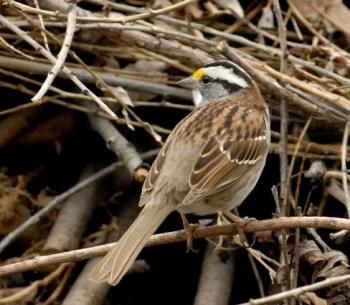Beautiful Springtime Music

White-throated Sparrow
Photo credit: Jim Williams
by Val Cunningham
Contributing Writer
This handsome little sparrow—and its ethereal song—often go unnoticed as it drops in for a visit before heading north.
After the first red-winged blackbirds blow in, after the robins bounce down, but before the Baltimore orioles begin arriving with their sweet whistled songs, a small sparrow flits through the underbrush before continuing its migratory journey.
This is the often-overlooked white-throated sparrow, one of my favorite birds of spring. Unless you look closely, you might not notice that this isn’t one of the neighborhood’s house sparrows—both kinds are scratching around under trees and shrubs and in garden beds. But white-throats are definitely worth a second look, because this is one of those rare, aptly named birds.
They do have a white throat, and it looks like a bright white ascot or bib just below the beak. Many also sport a head dramatically striped in black and white. But this sparrow also comes in another feather ensemble, a mousier coat with tan stripes on the head and a less-bright white throat.
These are the same bird species, just a variation in coloration. Some people think the tan-striped version is the female and the white-striped birds are the males. In fact, in many bird species, females are drabber than males, so the female is camouflaged as she sits on the nest. But what we have in this case are two distinctly different looks in birds of the same species.
Big time skippers
White-throats are the “skippers” of the sparrow world, known for their habit of hopping forward, then hopping backwards while dragging their feet along the ground. This pulls away any leaves, pine needles, twigs, mulch and anything else on top of the soil, thereby exposing tasty seeds or insects. Juncos do this, so do towhees and brown thrashers, but few birds seem to engage in the hop-skip maneuver with as much enthusiasm and vigor as white-throats. For such small birds, they can rearrange an amazing amount of detritus, as I rediscover each summer when I go out to rake mulch back into the garden beds, kicked out by these spring visitors.
What really makes these sparrows stand out is their lovely song, an almost plaintive-sounding series of two single notes followed by sets of three triple notes. Some say it sounds as if they’re singing “Old Sam Peabody, Peabody, Peabody,” or “Oh, sweet Canada, Canada, Canada.” (Hear it here).
Quite a few migratory sparrow species are on the move in spring, but most are wary of backyard feeders. Not so the white-throat: In addition to scuffling around at the base of trees and shrubs, this small, chubby-looking bird will visit feeders, especially the platform style or those with a tray. They enjoy sunflower seeds, millet, cracked corn and nyger seeds. Toss some millet under a low-branched tree or shrub and things should soon start hopping—literally.
Notes in the northland
If white-throats don’t stop by your backyard this spring, you can catch them this summer up north, where many of them nest. Wooded sections of Duluth ring with white-throat songs all summer long, as does Grand Marais and the Gunflint Trail, and points in between. Or you can look for them this fall, as they pass through again on their southward migration.
If this year stays true to form, then white-throated sparrows should have begun trickling in around the first of April, with their number increasing throughout the month. As early birds move on toward the far north, their places are taken by new arrivals. If there is plenty of food available, the ground under a tree or feeder may seem to be seething with sparrows.
So take another look at that flock of brownish birds this spring. Mixed in with the house sparrows may be some very dapper birds.
Mix and match
As noted above, white-throated sparrows may have bright white head stripes or drab tan stripes. This is very important to the sparrows, who almost always will pair up with a bird of the opposite head color. White stripes are worn by aggressive, dominant birds, while tan stripes indicate a less aggressive sparrow, one who will make a good parent. So white-striped males almost always choose tan-striped females as mates, and tan-striped males choose white-striped females. If two white-stripes paired up they’d be too aggressive to form a bond. And if two tan-stripe birds paired up they’d lack the moxie to defend a territory. In either case, half of their offspring will have white striped heads and half will be tan-striped.
St. Paul, Minnesota resident Val Cunningham, leads bird hikes for the St. Paul Audubon Society and writes about nature for local, regional and national newspapers and magazines.



